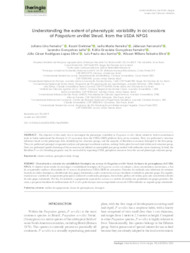Understanding the extent of phenotypic variability in accessions of Paspalum urvillei Steud. from the USDA NPGS.
Understanding the extent of phenotypic variability in accessions of Paspalum urvillei Steud. from the USDA NPGS.
Author(s): FERREIRA, J. L.; GWINNER, R.; FERREIRA, L. M.; FERRONATO, J.; LEITE, L. G.; FERREIRA, K. G. G.; SILVA, J. C. R. L.; SANTOS, L. P. dos; SILVA, A. W. T.
Summary: ABSTRACT - The objective of this study was to investigate the phenotypic variability in Paspalum urvillei Steud. related to twelve zootechnical traits to better understand the diversity of 41 accessions from the USDA GRIN platform from seven countries. First, we performed a structure inference based on the phenotypic data, identifying two structure groups, and the majority of Brazilian accessions belonged to the first group. Then, we performed principal component analysis and principal coordinate analysis, making Violin plots for each trait within each structure group. Next, we performed spatial clustering of the accessions and utilized an unweighted pair group method with arithmetic mean clustering. In brief, the Brazilian P. urvillei breeding programs may be successful by importing USDA germplasm resources from the second phenotypic structure group. Keywords: cluster analysis, germplasm bank, forage
Publication year: 2020
Types of publication: Journal article
Keywords: Banco de Germoplasma, Forragem
Observation
Some of Embrapa's publications are published as ePub files. To read them, use or download one of the following free software options to your computer or mobile device. Android: Google Play Books; IOS: iBooks; Windows and Linux: Calibre.
Access other publications
Access the Agricultural Research Database (BDPA) to consult Embrapa's full library collection and records.
Visit Embrapa Bookstore to purchase books and other publications sold by Embrapa.

